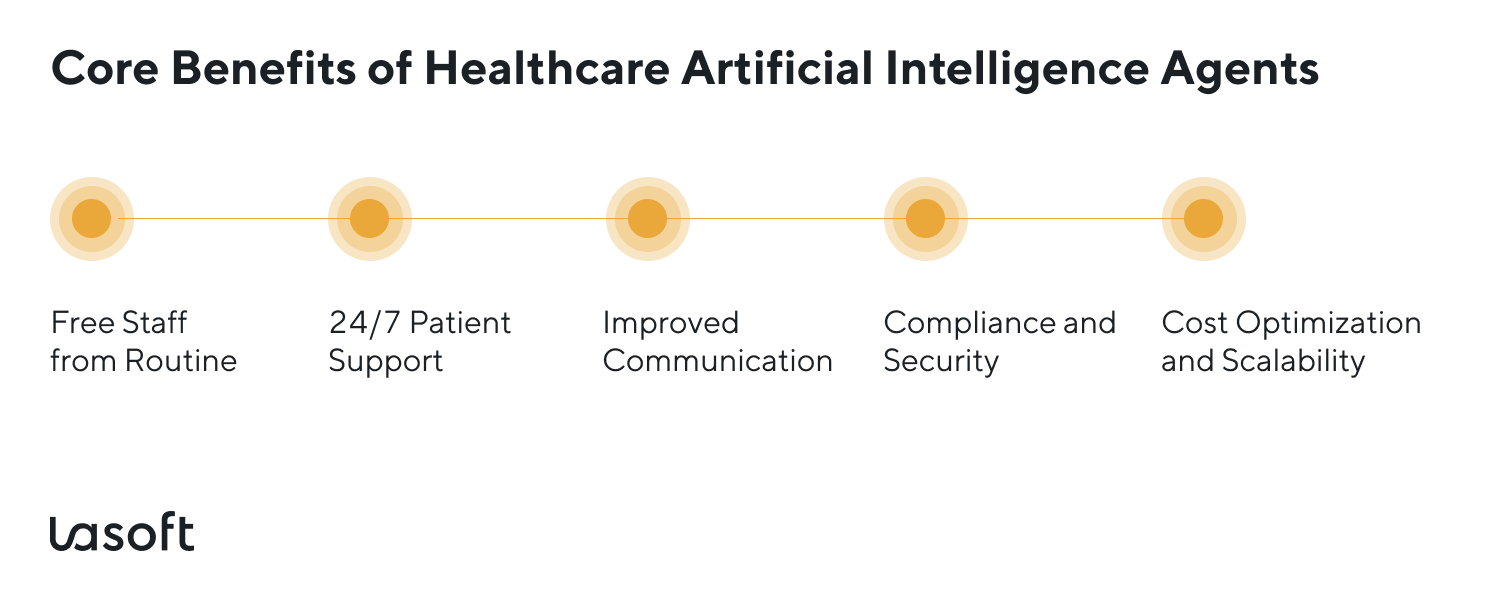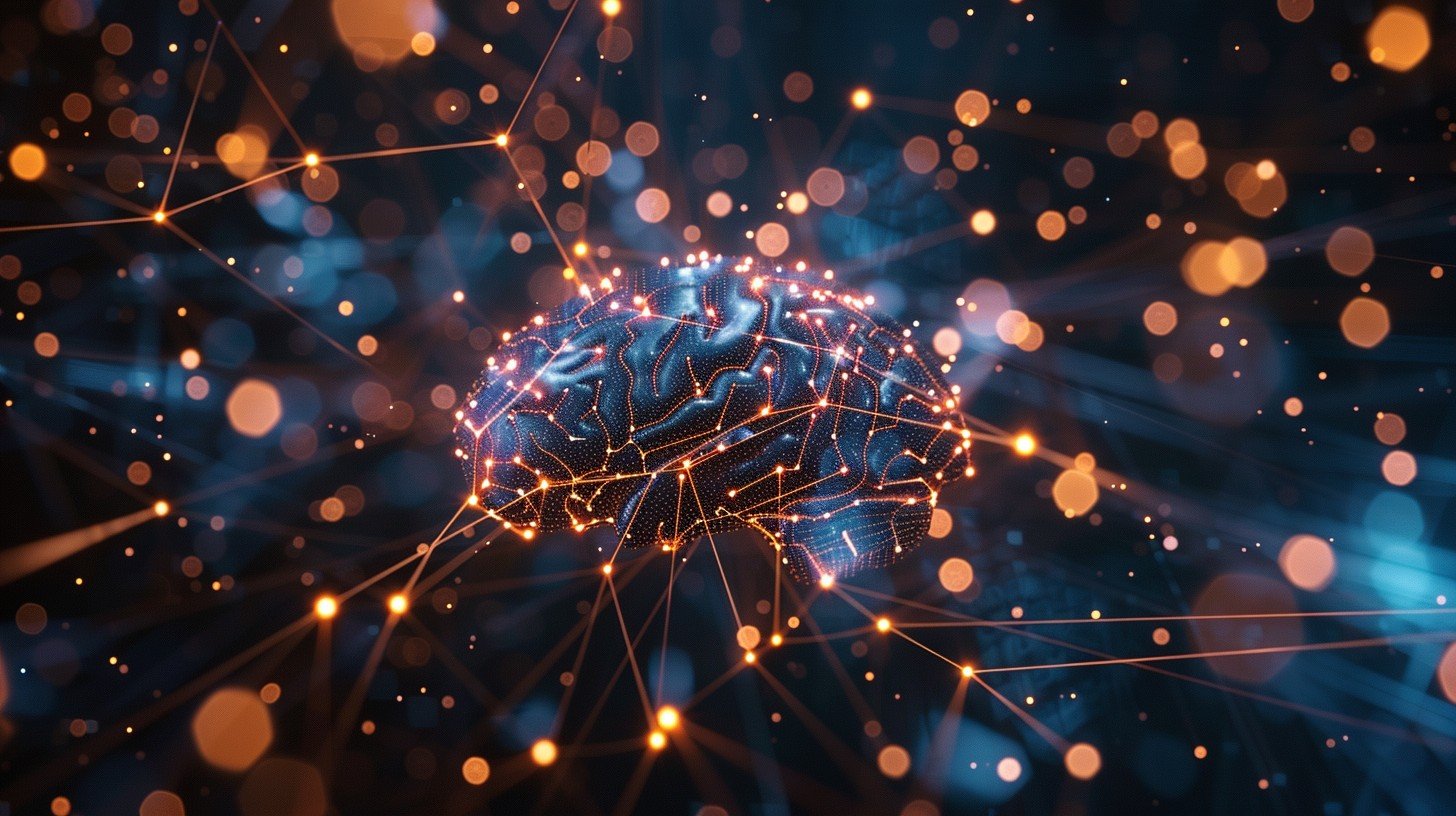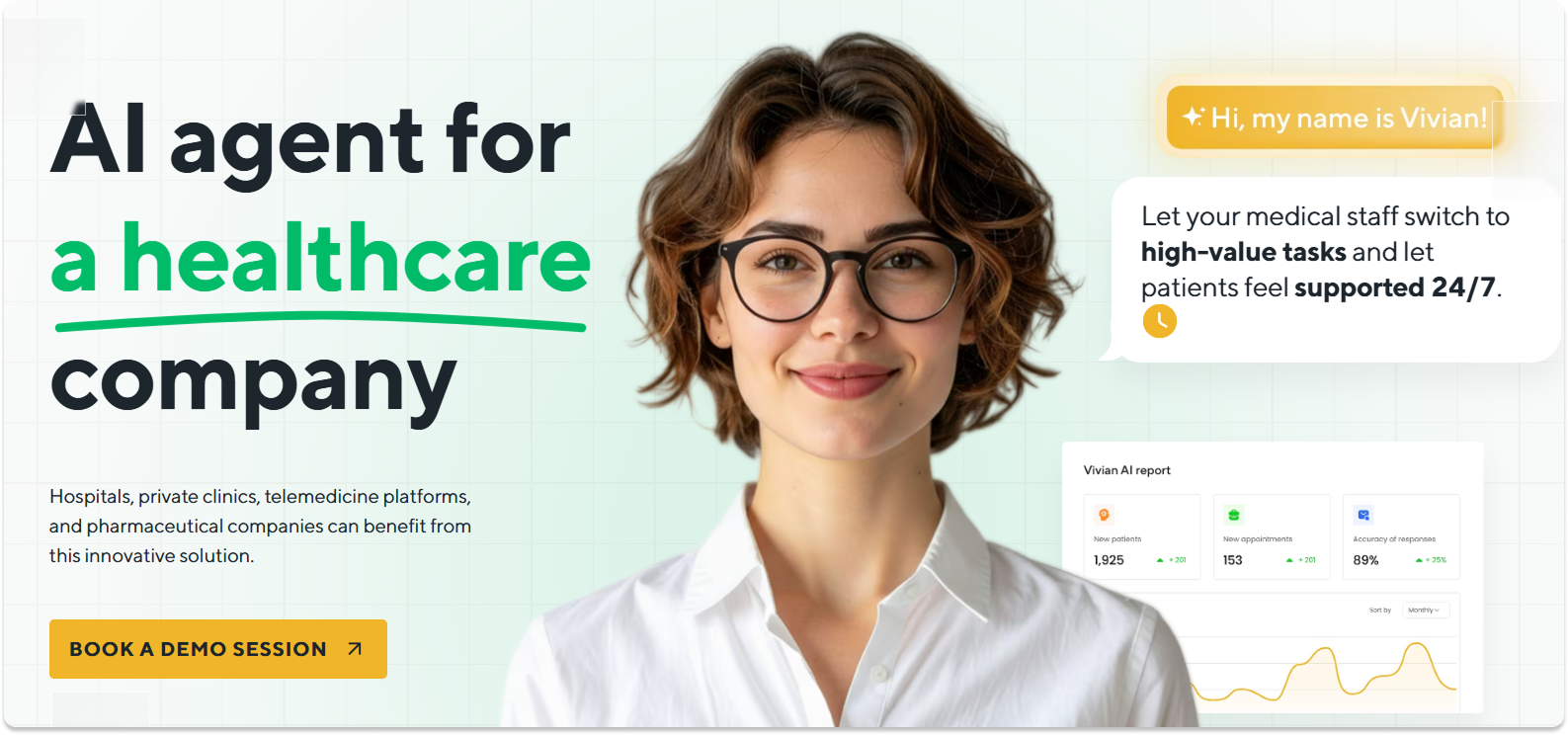How do we navigate the increasing healthcare challenges? There are countless, but we can name some of them right away. New viruses emerge, forcing medical systems to adapt in real-time. Researchers are racing to find a cure for cancer and other chronic diseases. Scientists are seeking ways to slow down the aging process to live longer.
However, the industry is facing one of its biggest challenges, a global shortage of skilled professionals. Fewer doctors, nurses, and pharmacists than the number of patients who need their help. Those who do are overwhelmed with administrative tasks, taking care of manual routine instead of focusing on what really matters: patient care, empathy, and clinical analysis.
Healthcare AI solutions extend clinical capacity and raise service levels with the staff you have. It actually helps with resource allocation by enabling medical staff to navigate manual work pressure with the automation of routine tasks, monitoring of patient data, acceleration of medical research, and support for drug discovery. Let’s see how hospitals and clinics can get a digital colleague that reduces workload, ensures compliance, and empowers healthcare professionals to deliver better outcomes with the time and resources they have.
Emerging Trends and Real-World Cases in Health Systems
Like any industry these days, the healthcare industry is undergoing a rapid transformation, driven by many factors, and rising treatment costs is one of them. So artificial intelligence is a practical solution to address the pressure by improving efficiency, accuracy, and patient outcomes. We refer to these emerging trends as predictive analytics, AI-powered diagnostics, personalized treatment plans, and virtual health assistants, which are being implemented in hospitals, clinics, and research institutions worldwide.
1. AI-powered Drug Discovery
AI models, particularly generative and molecular design algorithms, empower and accelerate the drug discovery pipeline, identifying new drug candidates, optimizing molecules, and repurposing existing compounds.
Halicin – AI-derived antibiotic: Researchers used in silico deep learning approaches to identify halicin, a broad-spectrum antibiotic, in just a few days. It showed activity against drug-resistant bacteria in vitro and in vivo. Source: Pubmed
2. Predictive Analytics
AI-driven predictive models can identify patients at high risk of readmission or complications, enabling doctors to intervene or optimize resources proactively.
Mayo Clinic (US): Researchers developed an AI algorithm that analyzes EKGs to predict atrial fibrillation before symptoms occur. This helps clinicians intervene earlier and prevent complications such as strokes.
3. Telemedicine
AI upgrades it from “video call” to end-to-end virtual service: patients complete guided intake, risk is triaged in minutes, clinicians receive concise summaries, and follow-ups are automated with reminders and adherence nudges. In practice, this means fewer no-shows, shorter consultations, and improved continuity:
- Guiding patients through initial questions and routing cases to the proper specialist.
- Symptom checkers and risk assessments.
- Reducing no-shows with alerts and reminders.
- Using patient history and data to enhance treatment recommendations.
K Health (US): An AI-powered telehealth app in which patients can input their symptoms and medical history and get possible conditions. The app then connects patients with licensed doctors for treatment, saving time for both patients and medical staff.
4. Disease Susceptibility & Long-Term Health Forecasting
Using large-scale models to predict an individual’s risk of developing diseases decades ahead, enabling preventive care and population-level planning.
Delphi-2M: It’s a generative AI model developed by European research institutions that predicts an individual’s risk for over 1,000 diseases over time. It utilizes anonymized health records (diagnoses, medical history), demographic information (age, sex), and lifestyle data (e.g., smoking, BMI, alcohol use). The model is based on a transformer/generative architecture (similar to large language models) adapted to process sequences of “medical events” rather than text. Source: Financial Times.
5. AI in Oncology
Cancer remains one of the most complex challenges in the field of medicine. Each patient’s tumor can have unique genetic and molecular characteristics, making treatment decisions difficult. Traditional methods of therapy include delayed responses and high costs. AI technology helps analyze vast amounts of genomic, imaging, and clinical data to enhance the process of getting actionable insights.
- Detection and diagnosis in early stages;
- AI recommends targeted therapies to work for a specific patient by integrating genomic data with clinical outcomes;
- Prediction of treatment, helping oncologists avoid ineffective regimens;
- AI helps match patients to clinical trials by analyzing tumor profiles and eligibility criteria.
PathAI: Collaborates with major hospitals to apply AI in digital pathology. It improves the accuracy of cancer diagnoses by helping detect subtle patterns that pathologists might miss.
These trends reveal several shifts in healthcare, but there are undoubtedly many more. It’s worth also mentioning that AI enhances domain experts (scientists, clinicians, pharmacists) and does not replace them.
Artificial Intelligence in Healthcare Sector, 2025-2035 (USD billion)
The global healthcare artificial intelligence (AI) market was valued at USD 7.36 billion in 2023 and is projected to increase from USD 9.28 billion in 2024 to nearly USD 120 billion by 2035. This represents a strong compound annual growth rate (CAGR) of approximately 26.2% between 2025 and 2035. Source: Marketresearchfuture
AI in Healthcare Technologies: Current vs. Future Use Cases
| Category | Current Use Cases
(Today) |
Future Use Cases
(Next 5–10 Years) |
|---|---|---|
| Administrative Automation | Streamline clinical workflows: Appointment scheduling; Insurance eligibility checks; Automated reminders and billing
|
Fully autonomous patient intake systems;
End-to-end workflow administration across departments |
| Patient Support | AI chatbots for FAQs;
Virtual symptom checkers; Medication reminders |
Hyper-personalized AI health coaches;
Multilingual, multimodal support (voice, video, text) |
| Clinical Decision Support | Drug interaction alerts;
Diagnostic imaging analysis (X-ray, MRI); Predicting readmissions |
Real-time clinical decision engines;
AI-assisted robotic surgery; |
| Pharma and Research | Drug repurposing;
Early cancer biomarker detection; Trial recruitment matching |
AI-designed molecules entering clinical use;
Generative biology for personalized therapies |
| Telemedicine and Virtual Care | Symptom triage bots;
Remote monitoring devices with AI alerts |
Fully AI-managed virtual clinics;
AI-guided rehabilitation and chronic care at home |
| Population Health | Predicting potential health risks and disease outbreaks; Identifying high-risk patient groups | AI forecasting decades-ahead risks |
| Oncology | Analyze medical images and pathology image recognition; Matching therapies to tumor profiles | AI-driven adaptive cancer treatment plans;
Real-time therapy response prediction |
Why Healthcare Needs AI Support with Administrative Tasks
Healthcare providers, whether they operate small private clinics or large hospital networks, are under constant pressure to deliver high-quality care, often with limited resources and manually handling tasks such as answering phone calls, scheduling appointments, and managing paperwork. While emerging technologies can launch advances and dramatically drive workflows, the way administrative work is dealt with in hospitals has changed little. Doctors, nurses, and support teams still spend hours every week on repetitive, manual tasks that drain time and energy away from patient care. For medical company owners, this is an operational headache and a strategic risk:
- Staff burnout and problems with retention: When highly trained medical professionals spend 30–40% of their time on paperwork, scheduling, and routine communication, they often feel dissatisfied with their work, and retention drops, while flight risks increase.
- Operational inefficiency: Slow, manual workflows result in longer wait times for patients, and the absence of automated reminders and notifications leads to an increase in missed appointments.
- Patient dissatisfaction: Today’s patients expect fast, digital-first interactions, similar to those in banking, retail, or telecom. If your system feels outdated, prepare yourself for bad feedback and complaints.
- Scaling challenges: As patient volumes increase and a medical staff gap emerges, healthcare facilities require more innovative ways to scale without compromising quality.
Core Benefits of Healthcare Artificial Intelligence Agents
The value of AI agents in the healthcare ecosystem lies in their ability to automate routine, repetitive workflows that traditionally consume hours of staff time every day. From the moment a patient reaches out to the hospital or clinic by phone, email, chat, or portal message, an AI agent manages interaction with patients. Instead of a receptionist or nurse spending valuable minutes manually entering appointment data, the AI instantly validates coverage, schedules the visit, locates medical records, and updates the system in real-time.
An AI agent goes far beyond scheduling and coverage validation. It manages reminders, alerts, and follow-ups, reducing the costly problem of no-shows. Patients get clear instructions about medications or treatment steps, sent by agents. An AI assistant can notify patients immediately about lab results and then answer basic questions, sending inquiries to medical staff only when it’s an urgent or complex case.
The healthcare provider wins it all. On the one hand, administrative overhead is reduced significantly, freeing teams from the endless cycle of paperwork, data entry, and routine phone calls. On the other hand, staff satisfaction improves because professionals can finally focus on the work for which they were trained.
Businesses across various industries are undergoing digital transformation, including the adoption of AI technology. Artificial intelligence in healthcare is explicitly a strategic solution that enables clinics, hospitals, and telemedicine platforms to optimize costs and deliver a level of care that builds reputation in the market and enhances patient experience.
Free Staff from Routine |
AI assists healthcare professionals to avoid administrative burdens and spend time on repetitive tasks such as:
By automating these workflows, AI agents allow medical professionals to focus on high-value interactions, disease diagnosis, and patient health outcomes. |
24/7 Patient Support |
The “always-on” approach and personalized medicine make patients feel supported at every stage of the patient flow.
|
Improved Communication |
Effective communication is one of the best medical practices that drives on-time feedback and saves lives. Responder, as one of the AI tools, helps with:
|
Compliance and Security |
Healthcare AI agents must be safe and trustworthy, and designed with a compliance-first architecture:
|
Cost Optimization and Scalability |
By handling high volumes of inquiries and administrative tasks, AI agents significantly reduce operational overhead. At the same time, they scale seamlessly as the organization grows—ensuring consistent quality and efficiency without increasing headcount. |

Meet Vivian from Lasoft: Always-On AI Healthcare Assistant
Imagine a healthcare assistant who never takes breaks, never gets tired, and never loses patience. Developed by LaSoft, Vivian is an AI-powered agent that interacts with patients and healthcare teams across multiple channels: phone calls, patient portal chats, WhatsApp, messages, and emails. For patients, agent Vivian provides clear answers to questions about prescriptions, appointments, or administrative processes.
For staff, she retrieves treatment protocols, verifies insurance details, and routes urgent cases to supervisors when needed. With a human-like approach and plain-language communication, Vivian follows principles that “anytime, anywhere” make healthcare more accessible and responsive.
Most importantly, Vivian is built with compliance and security at the core. Her architecture adheres strictly to HIPAA and GDPR rules, featuring role-based access, data encryption in transit and at rest, and comprehensive audit logging for reporting purposes. So healthcare organizations can trust her to support patient safety.
Final Recap
AI is a strategic solution. AI agents like Vivian from LaSoft show that automation can reduce workload, increase compliance and the bond between patients and medical staff. Instead of spending hours verifying insurance, scheduling appointments or answering repetitive questions, staff can rely on AI to do these tasks quickly and reliably – so they can focus on complex diagnoses, empathy and patient care.
AI speeds up drug discovery, predicts patient risks, powers telemedicine platforms, forecasts disease susceptibility, helps with early detection and even guides oncologists in providing personalized treatments. Not replacing professionals, AI is becoming their digital colleague – a tireless partner that works 24/7, scales with demand and always has patients’ backs.
For medical company owners and stakeholders, the question isn’t if AI will change healthcare; it’s how fast you can adopt it to protect your staff, streamline your operations, and deliver the patient experience the market demands today.
The future of healthcare is hybrid – human expertise with intelligent AI agents. By doing this today, your organisation can get better outcomes, reduce costs and stay ahead in an industry that’s moving faster than ever.
FAQs
What is an AI responder in healthcare?
An AI responder is a digital system that automatically responds to patient or staff questions using validated data sources, such as medical guidelines, clinical documentation, or electronic healthcare records. Unlike generic chatbots, a healthcare AI responder is trained to handle medical workflows, such as scheduling appointments, validating insurance, or providing drug information, while remaining compliant. For medical companies, this means fewer routine calls for staff and faster service for patients.
How does a custom AI agent change healthcare processes?
A custom AI agent automates the repetitive but essential tasks that slow down your team. For instance, when a patient asks about side effects or a lab result, the AI instantly retrieves the correct information from approved sources and provides a clear, human-like draft response. Staff only need to review or approve complex cases. This reduces administrative workload, shortens response times and creates a scalable support system that grows with your clinic or hospital.
Is an AI assistant HIPAA and GDPR compliant?
At LaSoft, every healthcare AI solution is developed with a compliance-first approach. All sensitive data is encrypted both in transit and at rest, with strict role-based access controls. Every interaction is logged for audit purposes, making it easy to demonstrate compliance with regulators. By design, our agents are compliant with HIPAA, GDPR, and any other internal policies your company may require.
What are the measurable benefits for medical company owners?
- Reduced operational costs: AI handles thousands of patient interactions simultaneously, eliminating the need for additional staff.
- Improved patient satisfaction: 24/7 support and faster response times build trust and loyalty.
- Less staff burnout: Doctors, nurses and administrators spend more time on meaningful tasks, not paperwork.
- Scalability: The system adapts to higher patient volumes without sacrificing quality.
What is healthcare automation, and why is it important?
Healthcare automation uses AI to streamline workflows such as appointment management, insurance verification, reporting and patient communications. For stakeholders, automation means lower overhead costs, increased efficiency, and more effective use of clinical expertise.
How does an AI virtual assistant improve patient care?
AI virtual assistants engage patients across multiple channels, including phone, chat, WhatsApp, and email, ensuring they consistently receive timely and accurate guidance. They can:
- Guide patients through non-critical treatment steps. Remind patients of their medications, upcoming check-ups, or scheduled lab tests.
- Escalate urgent cases to medical staff instantly.
- Reduce missed appointments and improve care adherence.
How is AI being used in hospitals and clinics today?
- Triage & risk assessment: Identifying high-risk cases earlier.
- Operational support: Automating registration, billing, and reporting.
- Clinical decision support: Highlighting drug interactions or treatment options.
- Patient engagement: Providing real-time, plain language explanations of diagnoses and treatments.
These solutions are already in use in hospitals worldwide, saving time, reducing costs, and enhancing patient safety.
What AI tools are most useful for healthcare organizations?
- AI responders & virtual assistants for patient interaction.
- Natural Language Processing (NLP) to parse medical documentation and extract insights.
- Predictive analytics to predict patient readmissions, complications or disease risks.
- Computer vision for diagnostic imaging.
- Generative AI for summarizing reports, creating plain language patient instructions and drafting regulatory documents.
How does generative AI help patient engagement?
Generative AI ensures patients get personalized, context-aware communication. It can translate complex medical terminology into simple language, summarize treatment steps, or generate reminders that keep patients on track. This fosters trust and compliance, thereby reducing the likelihood of missed medications or follow-ups.
Is AI meant to replace healthcare staff?
AI agents are designed to support, not replace, medical professionals. They are digital assistants that automate repetitive tasks, allowing staff to focus on empathy, expertise, and direct patient care. Owners and executives achieve greater efficiency and higher-quality care without unnecessarily growing headcount.



